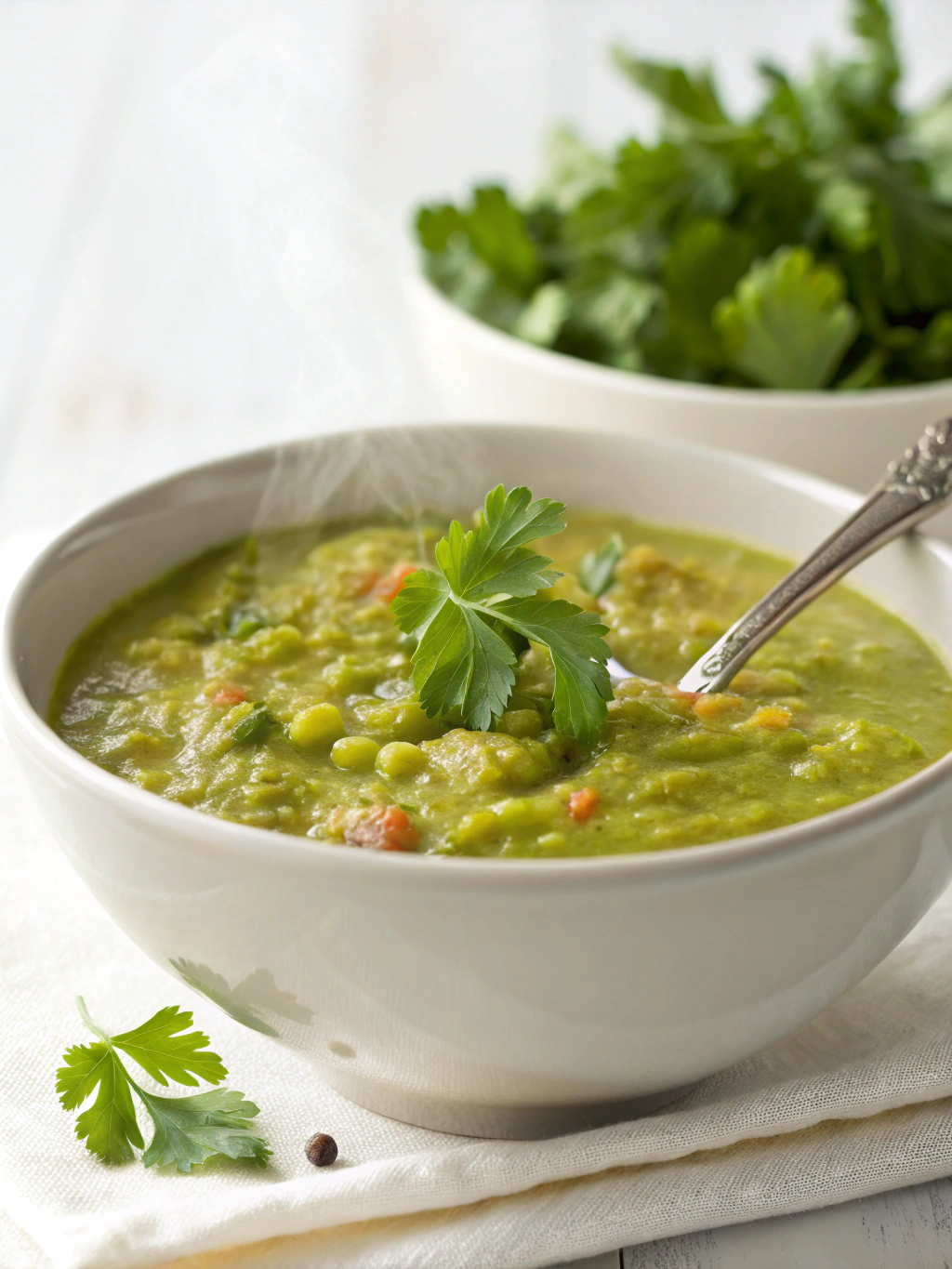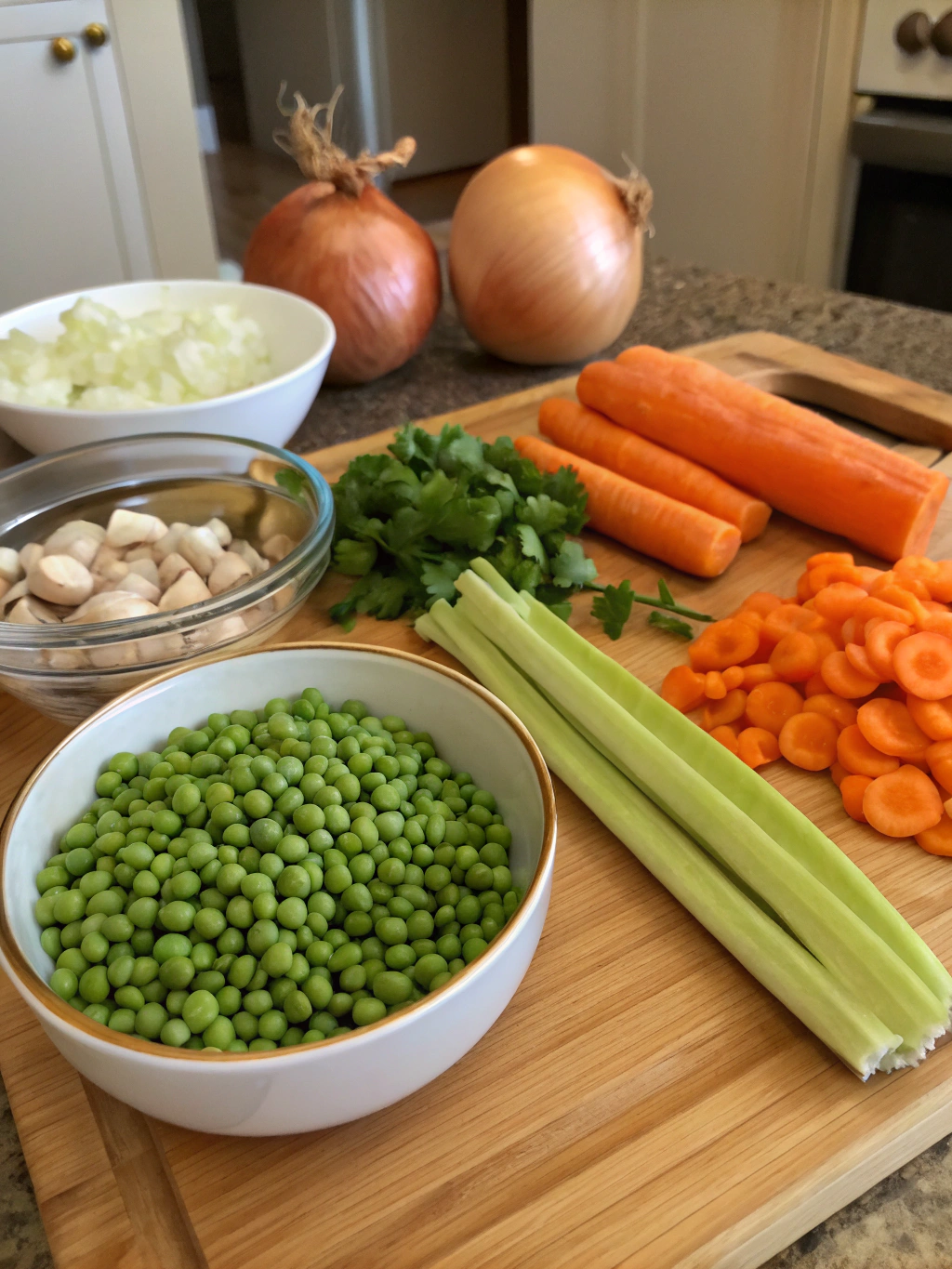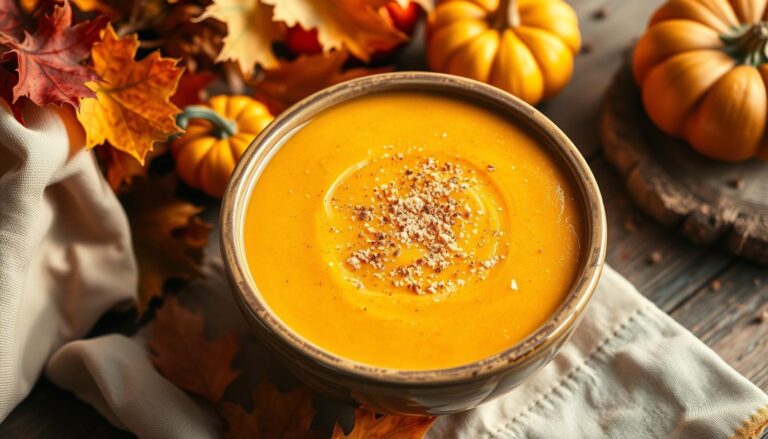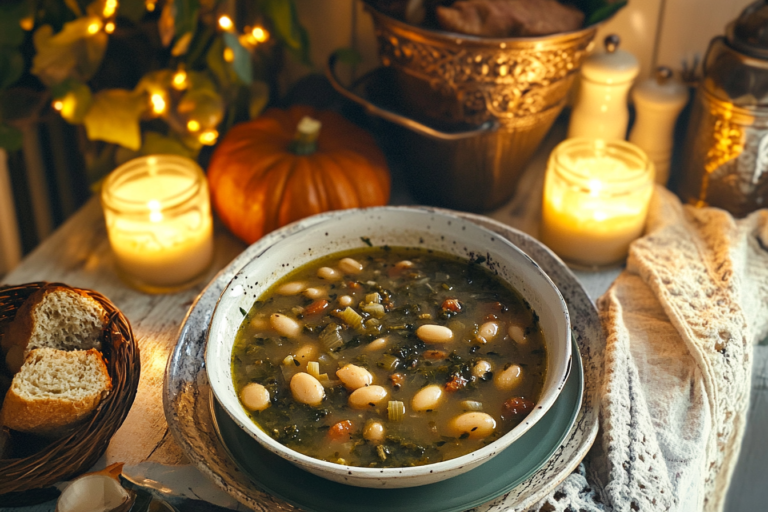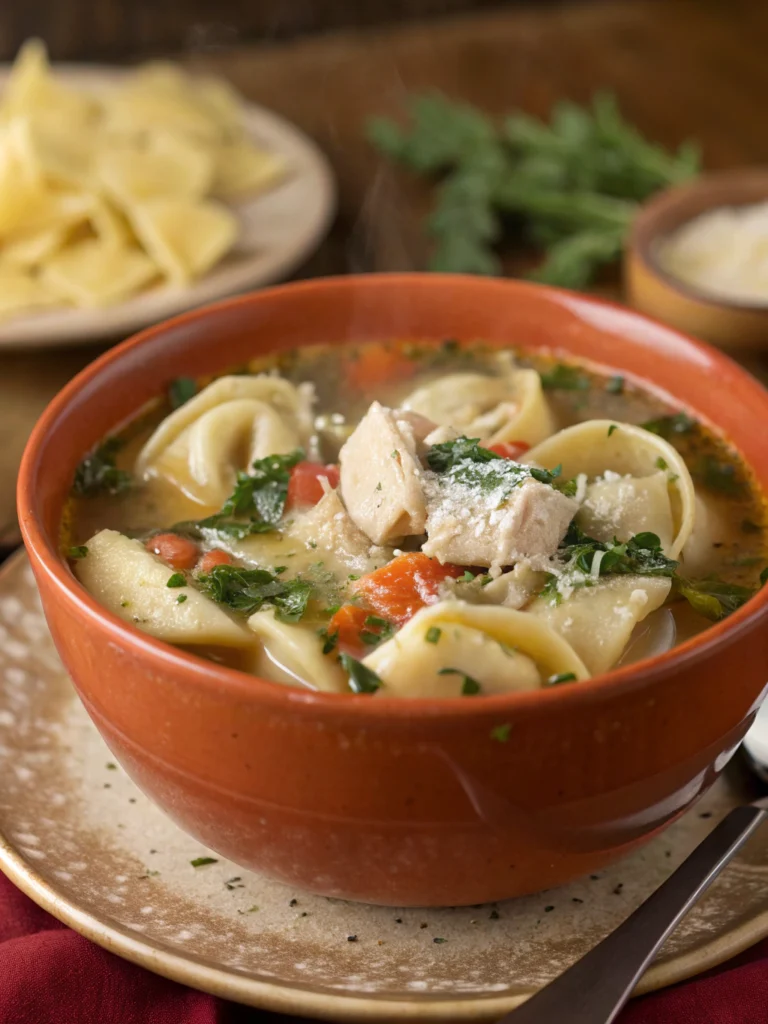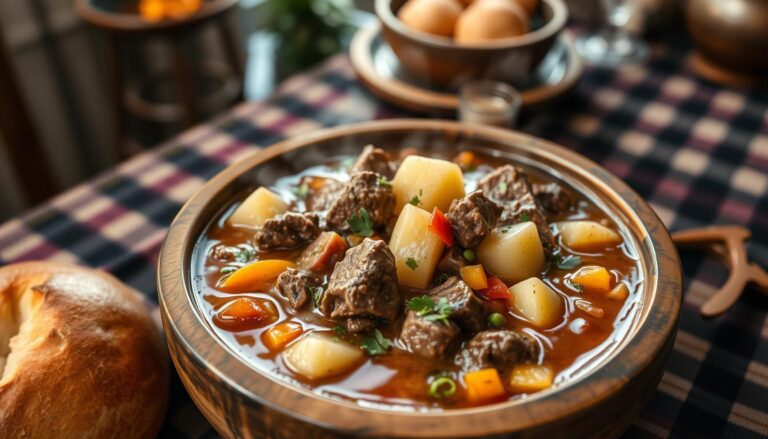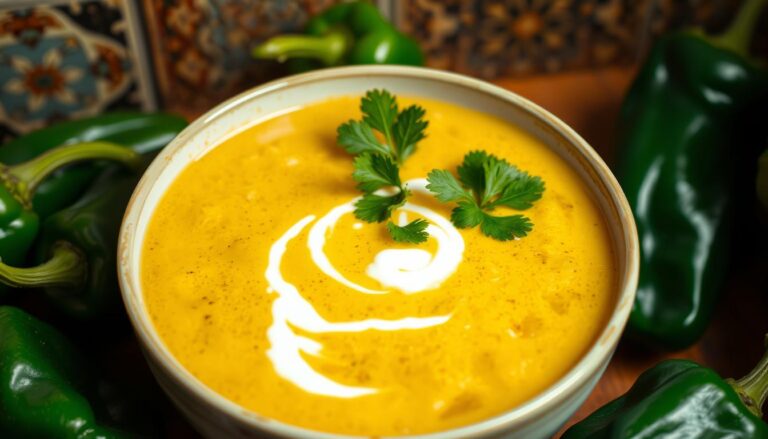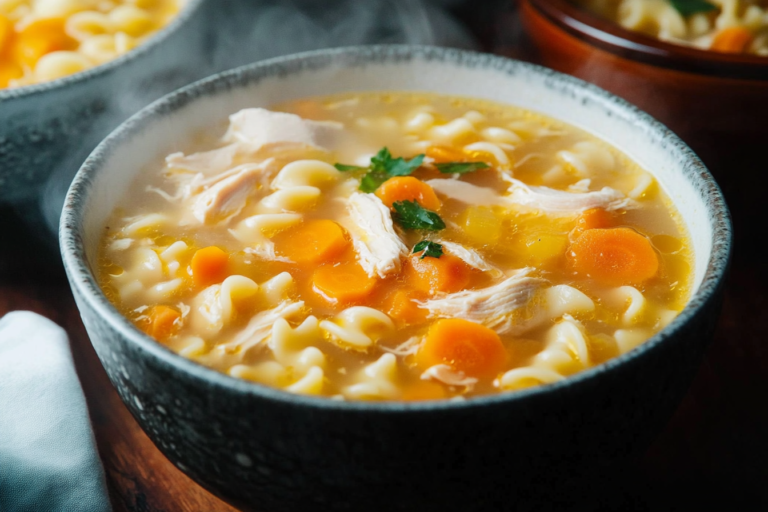Split Pea Soup
A hearty, comforting bowl of homemade split pea soup is the ultimate cold-weather comfort food. This traditional recipe transforms humble ingredients into a rich, satisfying meal that’s both economical and delicious. Perfect for meal prep and even better the next day!
Easy Split Pea Soup Recipe
There’s something profoundly comforting about a steaming bowl of split pea soup on a chilly day. This classic recipe has stood the test of time for good reason—it transforms simple, affordable ingredients into a nutritious, flavor-packed meal that satisfies to the core. Split pea soup has been a staple in kitchens across many cultures for centuries, traditionally made after enjoying a ham dinner to make the most of the leftover ham bone.
What makes this particular split pea soup recipe special is its perfect balance of simplicity and depth of flavor. The natural creaminess that develops as the split peas break down creates a luxurious texture without adding any dairy, making this soup naturally hearty without feeling heavy.
THIS RECIPE:
- Requires minimal active cooking time—just set it and let it simmer
- Uses budget-friendly ingredients for a cost-effective meal
- Creates a complete protein-packed meal in one pot
- Freezes beautifully for future quick meals
| Recipe Details | Information |
|---|---|
| Prep Time | 15 minutes |
| Cook Time | 1 hour 30 minutes |
| Total Time | 1 hour 45 minutes |
| Servings | 6-8 bowls |
| Yield | Approximately 3 quarts |
This split pea soup recipe strikes the perfect balance between ease of preparation and incredible flavor. You’ll spend just about 15 minutes actively working before allowing the ingredients to simmer into a rich, velvety soup. Whether you’re a seasoned cook or a kitchen novice, this recipe delivers consistent, delicious results every time with minimal effort.
Ingredients for Split Pea Soup
The quality of ingredients makes all the difference in split pea soup, transforming this humble dish into something truly special. Since there are relatively few components, each one contributes significantly to the final flavor profile. Starting with fresh vegetables and good quality dried peas creates the foundation for a soup with exceptional taste and texture.
For the Split Pea Soup:
- 1 pound (2¼ cups) dried green split peas, rinsed and sorted
- 1 meaty ham bone or 2 ham hocks
- 3 tablespoons olive oil
- 1 large onion, finely diced (about 1½ cups)
- 2 medium carrots, diced (about 1 cup)
- 2 stalks celery, diced (about ¾ cup)
- 3 cloves garlic, minced
- 1 teaspoon dried thyme
- 1 bay leaf
- 8 cups low-sodium chicken broth or stock
- 2 cups water
- 1½ cups diced ham (in addition to the ham bone)
- ½ teaspoon freshly ground black pepper
- Salt to taste (depending on saltiness of ham and broth)
- 2 tablespoons fresh lemon juice (optional, adds brightness)
For Garnish (Optional):
- Croutons
- Fresh chopped parsley
- Diced ham
- Sour cream or Greek yogurt
- Freshly cracked black pepper
When shopping for split peas, look for ones that are uniformly green without many discolorations. Older split peas can take significantly longer to soften, so check the packaging date if possible. For the ham bone or ham hocks, a bone from a smoked ham will provide the most flavor, though store-bought ham hocks work well too.
| Ingredient Category | Recommended Quantity | Quality Tips |
|---|---|---|
| Split Peas | 1 pound | Choose bright green peas without discoloration; rinse well and check for small stones |
| Ham | 1 meaty ham bone + 1½ cups diced | Use bone from a smoked ham if possible; for diced ham, avoid processed varieties with additives |
| Aromatics | 1 onion, 2 carrots, 2 celery stalks | Use fresh, firm vegetables; organic if possible for enhanced flavor |
| Liquid Base | 8 cups broth, 2 cups water | Homemade stock provides best flavor; choose low-sodium store-bought to control salt levels |
| Seasoning | Herbs, pepper, salt, lemon juice | Fresh herbs provide brightest flavor but dried work well; add lemon juice at end of cooking |
How to Make Split Pea Soup
Creating a perfect split pea soup is all about layering flavors and allowing the ingredients to simmer slowly, giving the peas time to break down into a naturally creamy texture. This process is relatively hands-off, making it ideal for weekend cooking when you’re busy with other activities but still want a home-cooked meal.
Prepare the peas: Spread the dried split peas on a light-colored surface and pick through them, removing any discolored peas or small stones. Rinse them thoroughly in a colander under cold water until the water runs clear.
Sauté the aromatics: In a large Dutch oven or heavy-bottomed pot, heat the olive oil over medium heat. Add the diced onion, carrots, and celery, cooking for 5-7 minutes until softened but not browned. Add the minced garlic and cook for another 30 seconds until fragrant.
Add seasonings: Stir in the dried thyme and cook for 30 seconds to bloom the flavor.
Combine main ingredients: Add the rinsed split peas, ham bone or hocks, bay leaf, chicken broth, and water to the pot. Bring to a boil over high heat.
Simmer: Once boiling, reduce heat to low, cover, and simmer for 60-90 minutes, stirring occasionally. The soup is ready when the peas have broken down and the soup has thickened to your desired consistency.
Prepare the ham: While the soup simmers, if using a ham bone, remove it after about an hour. Let it cool slightly, then remove any meat from the bone, chop it, and return it to the pot along with any additional diced ham.
Adjust texture: If the soup becomes too thick during cooking, add more water or broth to reach your preferred consistency. For a smoother soup, use an immersion blender to partially blend some of the soup, or transfer a portion to a standard blender, blend, and return to the pot.
Final seasoning: Remove the bay leaf. Add freshly ground black pepper and taste for salt, adding only if needed (ham and broth often provide sufficient saltiness). If using, stir in the fresh lemon juice to brighten the flavors.
Rest: Allow the soup to rest off the heat for 5-10 minutes before serving, as it will continue to thicken slightly and the flavors will meld.
Pro tip: For the creamiest texture, maintain a gentle simmer rather than a rolling boil. Too vigorous boiling can cause the peas to remain separate rather than breaking down smoothly.
Tips for Making Split Pea Soup
Getting your split pea soup just right depends on understanding a few key techniques that professional chefs use. These insights will help you avoid common pitfalls and elevate your soup to restaurant quality.
• Don’t skip sautéing the vegetables – This crucial step develops a flavor foundation that infuses the entire soup.
• Keep the simmer gentle – A slow, gentle simmer helps split peas break down evenly for the perfect creamy texture.
• Check peas for doneness – Different batches of split peas may take different amounts of time to fully soften.
• Season at the end – Wait until the soup is nearly finished to adjust salt levels, as the ham and broth can contribute significant saltiness.
| Technique | Recommendation | Why It Matters |
|---|---|---|
| Pea Soaking | Optional, not required | Using unsoaked peas leads to a more flavorful soup as they absorb the broth while cooking |
| Cooking Time | Minimum 60 minutes | Patience allows peas to fully break down for the creamiest texture |
| Thickness Control | Add liquid gradually | Easier to thin a thick soup than thicken a thin one |
| Flavor Development | Add ham in stages | Use bone during cooking for base flavor, add diced ham later for distinct meaty bites |
When it comes to achieving that perfect viscosity, remember that split pea soup will continue to thicken as it cools. If you prefer a smoother soup, an immersion blender works wonders for controlling exactly how much texture remains. For the richest flavor, try making the soup a day ahead—like many soups and stews, split pea soup often tastes even better the second day after the flavors have had time to meld.
Make-Ahead Instructions
Split pea soup is an ideal candidate for make-ahead meal preparation, as the flavors actually improve with time. Here’s how to prepare this soup in advance for maximum convenience and flavor.
You can make the complete soup up to 3 days before serving. After cooking, allow it to cool completely before transferring to airtight containers in the refrigerator. When reheating, you’ll notice the soup has thickened considerably—this is normal and easily remedied by adding a splash of water or broth to reach your desired consistency.
For longer advance preparation, consider these component-based approaches:
- Chop all vegetables up to 2 days in advance and store in airtight containers in the refrigerator
- Measure and rinse split peas the night before and store in the refrigerator
- If using a leftover ham bone, you can freeze it for up to 3 months until you’re ready to make soup
When ready to serve pre-made soup, reheat it gently on the stovetop over medium-low heat, stirring occasionally to prevent scorching. Add liquid as needed and adjust seasonings, as flavors may have intensified during storage.
Pro tip: If making ahead for a dinner party, prepare the soup a day in advance but slightly thinner than you’d prefer. As it sits overnight and then reheats, it will reach the perfect consistency, and the flavors will have melded beautifully.
Storing Leftovers
Proper storage of leftover split pea soup ensures you can enjoy its delicious flavor for days to come while maintaining food safety standards.
Store completely cooled split pea soup in airtight containers in the refrigerator for up to 4 days. Glass containers with tight-fitting lids work best for maintaining flavor and preventing leaks. To cool the soup quickly and safely, transfer it to shallow containers and allow it to cool for no more than 2 hours at room temperature before refrigerating.
When reheating refrigerated split pea soup, warm it slowly on the stovetop over medium-low heat, stirring frequently. You’ll need to add a small amount of water or broth (approximately ¼ cup per serving) as the soup will have thickened considerably while chilling. Heat until the internal temperature reaches at least 165°F (74°C) for food safety.
Individual portions can be reheated in the microwave in microwave-safe bowls. Cover with a microwave-safe lid or paper towel, and heat on medium power in 1-minute intervals, stirring between each interval until thoroughly heated.
Freezing Split Pea Soup
Split pea soup freezes exceptionally well, making it perfect for batch cooking and meal planning. The high fiber content helps the soup maintain its texture even after freezing and thawing.
To freeze split pea soup properly:
- Cool the soup completely in the refrigerator before freezing to prevent ice crystal formation
- Portion into freezer-safe containers or heavy-duty freezer bags, leaving about 1 inch of headspace for expansion
- Label each container with the date and contents
- For quicker thawing, freeze in flat layers in freezer bags or in single-serving portions
- Store in the freezer for up to 3 months for optimal quality
When you’re ready to enjoy the frozen soup:
- Thaw overnight in the refrigerator (safest method) or use the defrost function on your microwave
- Transfer the thawed soup to a pot and reheat gently on the stovetop over medium-low heat
- Stir frequently as it heats, adding a small amount of broth or water to adjust the consistency
- Bring to a simmer and heat until the internal temperature reaches 165°F (74°C)
Pro tip: If you’re planning to freeze the soup, consider slightly undercooking it initially, as the peas will soften more during reheating. Also, add any fresh herbs after thawing and reheating rather than before freezing to preserve their bright flavors.
Serving Suggestions
A steaming bowl of split pea soup can stand alone as a complete meal, but thoughtful accompaniments can elevate it to a truly memorable dining experience.
Traditional accompaniments that pair beautifully with split pea soup include:
- Crusty artisan bread or warm dinner rolls for dipping
- A classic grilled cheese sandwich for the ultimate comfort food pairing
- Simple green salad with a light vinaigrette to balance the soup’s richness
- Oyster crackers or homemade croutons sprinkled on top for crunch
For elegant presentation, serve the soup in preheated bowls and top with a swirl of quality olive oil or a dollop of sour cream. Sprinkle with fresh herbs just before serving—parsley adds a bright color contrast, while fresh thyme enhances the soup’s earthy flavors. A few additional diced pieces of ham and a twist of freshly cracked black pepper make for a restaurant-worthy presentation.
Beverage pairings that complement split pea soup include:
- A medium-bodied white wine like Viognier or Chardonnay
- Light-bodied red wine such as Pinot Noir
- A crisp, cold lager or amber ale
- Hot apple cider during fall and winter months
Serve split pea soup hot but not scalding—around 160°F is the ideal temperature for appreciating all its complex flavors while still warming you from the inside out.
FAQ
Can I make split pea soup without ham?
Yes! For a vegetarian version, omit the ham and use vegetable broth instead of chicken broth. Add depth of flavor with 1 teaspoon of smoked paprika and 1 tablespoon of soy sauce or tamari, which provide umami qualities similar to the ham. You can also add a tablespoon of olive oil at the end of cooking for richness.
How can I thicken my split pea soup if it’s too thin?
If your soup hasn’t thickened naturally, continue cooking uncovered to reduce the liquid. Alternatively, remove about 2 cups of the soup, blend until smooth, and return to the pot. For immediate thickening, you can make a slurry with 1 tablespoon of cornstarch dissolved in 2 tablespoons of cold water, add it to the simmering soup, and cook for another 5 minutes.
What makes my split peas still hard after hours of cooking?
Several factors can prevent split peas from softening:
- Age of the peas—older peas take significantly longer to soften
- Hard water—minerals in water can prevent softening; try filtered water
- Acidic ingredients—avoid adding acidic ingredients like tomatoes or vinegar until peas have softened
- High altitude—cooking at higher altitudes requires longer cooking times
Can I make split pea soup in a slow cooker or Instant Pot?
Absolutely! For a slow cooker, sauté the vegetables first, then combine all ingredients and cook on low for 8 hours or high for 4-5 hours. For an Instant Pot, use the sauté function for the vegetables, add remaining ingredients, and cook on high pressure for 15 minutes with a natural pressure release for 15 minutes afterward. You may need to adjust liquid amounts for both methods.
What is that foam that forms during cooking, and should I remove it?
The foam consists of water-soluble proteins released from the peas during cooking. While not harmful, skimming it off during the first 15-20 minutes of simmering will result in a clearer, more visually appealing soup. After this initial period, the foam will typically reincorporate into the soup.

